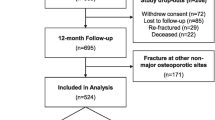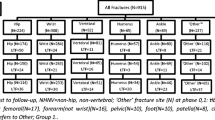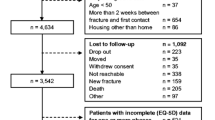Abstract
Summary
In this study of 695 Australian older adults (aged ≥50 years), we found that men and women had a similar trajectory of health-related quality of life (HRQoL) recovery following fragility fracture at any skeletal site. These results provide us with critical knowledge that improves our understanding of health outcomes post-fracture.
Introduction
Mortality is higher in men than that in women following a fragility fracture, but it is unclear whether recovery of patient-reported outcomes such as health-related quality of life (HRQoL) differs between sexes. This study aimed to identify sex differences in HRQoL recovery 12 months post-fracture.
Methods
Data were from the Australian arm of the International Costs and Utilities Related to Osteoporotic Fractures Study (AusICUROS). Participants recruited to AusICUROS were adults aged ≥50 years who sustained a fragility fracture. HRQoL was measured using the EQ-5D-3L at three time-points post-fracture: within 2 weeks (including pre-fracture recall) and at 4 and 12 months. Multivariate logistic regression analyses were undertaken, adjusting for confounders including age, education, income, and healthcare utilization post-fracture.
Results
Overall, 695 AusICUROS participants (536 women, 77.1%) were eligible for analysis with fractures at the hip (n = 150), distal forearm (n = 261), vertebrae (n = 61), humerus (n = 52), and other skeletal sites (n = 171). At the time of fracture, men were younger, reported a higher income, and were more likely to be employed, compared with women. For all fracture sites combined, there were no differences between men and women in recovery to pre-fracture HRQoL at 12-month follow-up (adjusted OR = 1.09; 95% CI: 0.75–1.61). When stratified by fracture site, no significant sex differences were seen for hip (OR = 1.02; 95% CI: 0.42–2.52), distal forearm (OR = 1.60; 95% CI: 0.68–3.78), vertebral (OR = 2.28; 95% CI: 0.61–8.48), humeral (OR = 1.62; 95% CI: 0.16–9.99), and other fractures (OR = 1.00; 95% CI: 0.44–2.26).
Conclusion
Community-dwelling men and women who survived the 12 months following fragility fracture had a similar trajectory of HRQoL recovery at any skeletal site.


Similar content being viewed by others
References
Strom O, Borgstrom F, Kanis JA, Compston J, Cooper C, McCloskey EV, Jonsson B (2011) Osteoporosis: burden, health care provision and opportunities in the EU: a report prepared in collaboration with the International Osteoporosis Foundation (IOF) and the European Federation of Pharmaceutical Industry Associations (EFPIA). Arch Osteoporos 6:59–155
Kanis JA, Oden A, Johnell O, Jonsson B, de Laet C, Dawson A (2001) The burden of osteoporotic fractures: a method for setting intervention thresholds. Osteoporos Int 12:417–427
Dempster DW (2011) Osteoporosis and the burden of osteoporosis-related fractures. Am J Manag Care 17:S164
Borgstrom F, Karlsson L, Ortsater G et al (2020) Fragility fractures in Europe: burden, management and opportunities. Arch Osteoporos 15:59
Pisani P, Renna MD, Conversano F, Casciaro E, Di Paola M, Quarta E, Muratore M, Casciaro S (2016) Major osteoporotic fragility fractures: risk factor updates and societal impact. World J Orthop 7:171–181
Svedbom A, Borgstom F, Hernlund E et al (2018) Quality of life for up to 18 months after low-energy hip, vertebral, and distal forearm fractures-results from the ICUROS. Osteoporos Int 29:557–566
Abimanyi-Ochom J, Watts JJ, Borgstrom F et al (2015) Changes in quality of life associated with fragility fractures: Australian arm of the International Cost and Utility Related to Osteoporotic Fractures Study (AusICUROS). Osteoporos Int 26:1781–1790
Bliuc D, Nguyen ND, Milch VE, Nguyen TV, Eisman JA, Center JR (2009) Mortality risk associated with low-trauma osteoporotic fracture and subsequent fracture in men and women. JAMA 301:513–521
Cauley JA, Hochberg MC, Lui LY, Palermo L, Ensrud KE, Hillier TA, Nevitt MC, Cummings SR (2007) Long-term risk of incident vertebral fractures. JAMA 298:2761–2767
Kumar V, Abbas AK, Aster JC (2015) Robbins and Cotran pathologic basis of disease. Elsevier/Saunders, Philadelphia, PA
Hannan MT, Felson DT, Dawson-Hughes B, Tucker KL, Cupples LA, Wilson PW, Kiel DP (2000) Risk factors for longitudinal bone loss in elderly men and women: the Framingham Osteoporosis Study. J Bone Miner Res 15:710–720
Sigurdsson G, Aspelund T, Chang M, Jonsdottir B, Sigurdsson S, Eiriksdottir G, Gudmundsson A, Harris TB, Gudnason V, Lang TF (2006) Increasing sex difference in bone strength in old age: the Age, Gene/Environment Susceptibility-Reykjavik study (AGES-REYKJAVIK). Bone 39:644–651
Curtis EM, van der Velde R, Moon RJ, van den Bergh JP, Geusens P, de Vries F, van Staa TP, Cooper C, Harvey NC (2016) Epidemiology of fractures in the United Kingdom 1988-2012: variation with age, sex, geography, ethnicity and socioeconomic status. Bone 87:19–26
Kanis JA, Johnell O, Oden A, Sembo I, Redlund-Johnell I, Dawson A, De Laet C, Jonsson B (2000) Long-term risk of osteoporotic fracture in Malmo. Osteoporos Int 11:669–674
van Staa TP, Dennison EM, Leufkens HG, Cooper C (2001) Epidemiology of fractures in England and Wales. Bone 29:517–522
Amarilla-Donoso FJ, Lopez-Espuela F, Roncero-Martin R, Leal-Hernandez O, Puerto-Parejo LM, Aliaga-Vera I, Toribio-Felipe R, Lavado-Garcia JM (2020) Quality of life in elderly people after a hip fracture: a prospective study. Health Qual Life Outcomes 18:71
Sylliaas H, Thingstad P, Wyller TB, Helbostad J, Sletvold O, Bergland A (2012) Prognostic factors for self-rated function and perceived health in patient living at home three months after a hip fracture. Disabil Rehabil 34:1225–1231
Van Son MAC, De Vries J, Zijlstra W, Roukema JA, Gosens T, Verhofstad MHJ, Den Oudsten BL (2017) Trajectories in quality of life of patients with a fracture of the distal radius or ankle using latent class analysis. Qual Life Res 26:3251–3265
Adachi JD, Loannidis G, Berger C, Joseph L, Papaioannou A, Pickard L, Papadimitropoulos EA, Hopman W, Poliquin S, Prior JC, Hanley DA, Olszynski WP, Anastassiades T, Brown JP, Murray T, Jackson SA, Tenenhouse A, Canadian Multicentre Osteoporosis Study (CaMos) Research Group (2001) The influence of osteoporotic fractures on health-related quality of life in community-dwelling men and women across Canada. Osteoporos Int 12:903–908
Papaioannou A, Kennedy CC, Ioannidis G et al (2009) The impact of incident fractures on health-related quality of life: 5 years of data from the Canadian Multicentre Osteoporosis Study. Osteoporos Int 20:703–714
Mizrahi EH, Arad M, Fleissig Y, Adunsky A (2014) Gender differences in functional outcome of elderly hip fracture patients. Geriatr Gerontol Int 14:845–850
Di Monaco M, Castiglioni C, Vallero F, Di Monaco R, Tappero R (2012) Men recover ability to function less than women do: an observational study of 1094 subjects after hip fracture. Am J Phys Med Rehabil 91:309–315
Lahtinen A, Leppilahti J, Vähänikkilä H, Kujala S, Ristiniemi J, Jalovaara P (2020) No major differences in recovery after hip fracture between home-dwelling female and male patients. Scand J Surg 109:250–264
Beaupre LA, Carson JL, Noveck H, Magaziner J (2015) Recovery of walking ability and return to community living within 60 days of hip fracture does not differ between male and female survivors. J Am Geriatr Soc 63:1640–1644
Endo Y, Aharonoff GB, Zuckerman JD, Egol KA, Koval KJ (2005) Gender differences in patients with hip fracture: a greater risk of morbidity and mortality in men. J Orthop Trauma 19:29–35
Hawkes WG, Wehren L, Orwig D, Hebel JR, Magaziner J (2006) Gender differences in functioning after hip fracture. J Gerontol A Biol Sci Med Sci 61:495–499
Chou FP, Chang HC, Yeh CC, Wu CH, Cherng YG, Chen TL, Liao CC (2020) Sex differences in fracture outcomes within Taiwan population: a nationwide matched study. PLoS One 15:e0231374
Szende A, Oppe M, Devlin NJ, EuroQol Group (2007) EQ-5D value sets : inventory, comparative review, and user guide. Springer, Dordrecht
Viney R, Norman R, King MT, Cronin P, Street DJ, Knox S, Ratcliffe J (2011) Time trade-off derived EQ-5D weights for Australia. Value Health 14:928–936
Roset M, Badia X, Mayo NE (1999) Sample size calculations in studies using the EuroQol 5D. Qual Life Res 8:539–549
Si L, Winzenberg T, De Graaff B, Palmer A (2014) A systematic review and meta-analysis of utility-based quality of life for osteoporosis-related conditions. Osteoporos Int 25:1987–1997
Gjertsen JE, Baste V, Fevang JM, Furnes O, Engesaeter LB (2016) Quality of life following hip fractures: results from the Norwegian hip fracture register. BMC Musculoskelet Disord 17:265
Dyer SM, Crotty M, Fairhall N, Magaziner J, Beaupre LA, Cameron ID, Sherrington C (2016) A critical review of the long-term disability outcomes following hip fracture. BMC Geriatr 16:158
Cunningham TD, Di Pace BS, Ullal J (2014) Osteoporosis treatment disparities: a 6-year aggregate analysis from national survey data. Osteoporos Int 25:2199–2208
van der Velde RY, Wyers CE, Teesselink E, Geusens P, van den Bergh JPW, de Vries F, Cooper C, Harvey NC, van Staa TP (2017) Trends in oral anti-osteoporosis drug prescription in the United Kingdom between 1990 and 2012: variation by age, sex, geographic location and ethnicity. Bone 94:50–55
Balasubramanian A, Tosi LL, Lane JM, Dirschl DR, Ho PR, O’Malley CD (2014) Declining rates of osteoporosis management following fragility fractures in the U.S., 2000 through 2009. J Bone Joint Surg Am 96:e52
Nakayama A, Major G, Holliday E, Attia J, Bogduk N (2016) Evidence of effectiveness of a fracture liaison service to reduce the re-fracture rate. Osteoporos Int 27:873–879
Talevski J, Sanders KM, Duque G, Connaughton C, Beauchamp A, Green D, Millar L, Brennan-Olsen SL (2019) Effect of clinical care pathways on quality of life and physical function after fragility fracture: a meta-analysis. J Am Med Dir Assoc 20(926):e921–926 e911
Talevski J, Sanders KM, Busija L, Beauchamp A, Duque G, Borgström F, Kanis JA, Svedbom A, Connaughton C, Stuart AL, Brennan-Olsen SL (2021) Health service use and quality of life recovery 12 months following major osteoporotic fracture: latent class analyses of the International Costs and Utilities Related to Osteoporotic Fractures Study (ICUROS). J Bone Miner Res 36:252–261
Talevski J, Sanders KM, Busija L, Beauchamp A, Duque G, Borgstrom F, Kanis JA, Svedbom A, Stuart AL, Brennan-Olsen S (2021) Health service use pathways associated with recovery of quality of life at 12-months for individual fracture sites: analyses of the International Costs and Utilities Related to Osteoporotic fractures Study (ICUROS). Bone 144:115805
Kaufman JM, Reginster JY, Boonen S, Brandi ML, Cooper C, Dere W, Devogelaer JP, Diez-Perez A, Kanis JA, McCloskey E, Mitlak B, Orwoll E, Ringe JD, Weryha G, Rizzoli R (2013) Treatment of osteoporosis in men. Bone 53:134–144
Lee KH, Xu H, Wu B (2020) Gender differences in quality of life among community-dwelling older adults in low- and middle-income countries: results from the Study on global AGEing and adult health (SAGE). BMC Public Health 20:114
Hutchinson AF, Graco M, Rasekaba TM, Parikh S, Berlowitz DJ, Lim WK (2015) Relationship between health-related quality of life, comorbidities and acute health care utilisation, in adults with chronic conditions. Health Qual Life Outcomes 13:69
Wilson IB, Cleary PD (1995) Linking clinical variables with health-related quality of life. A conceptual model of patient outcomes JAMA 273:59–65
Szende A, Janssen B, Cabases J (2014) Self-reported population health: an international perspective based on EQ-5D. Springer Netherlands Dordrecht,
Acknowledgements
We are grateful to the quality of life and Epidemiology Working Group of the Committee of Scientific Advisors for the International Osteoporosis Foundation under whose supervision ICUROS was undertaken.
Data and materials availability
The data for these analyses was accessed from the AusICUROS central database. Access to this database should be discussed with the data custodian (KMS).
Code availability
Not applicable.
Funding
JT is supported by an Australian National Health and Medical Research Council (NHMRC, of Australia) Postgraduate Scholarship (1151089). AusICUROS was supported by the NHMRC (Project Grant Number: 628422) with subsidiary funding support from Merck Australia Pty Ltd.
Author information
Authors and Affiliations
Contributions
KMS (principal investigator), JJW, GCN, SI, RP, LM, TW, PE, and GD are chief investigators of the AusICUROS. JT, KMS, and SLB-O contributed to the investigated research question, including conception and design. JT designed and executed the statistical analyses with assistance from SLB-O. JT led the interpretation of findings with inputs from all authors. JT drafted all sections of the manuscript. All authors provided critical input regarding interpretation of results and approved the final manuscript for publication.
Corresponding author
Ethics declarations
Ethics approval
AusICUROS was approved by the relevant human research ethics committees (HREC) in each of the eight participating study centers in Australia (lead site Barwon Health HREC: 09/49). Approval for the use of the AusICUROS data for these analyses was obtained from Melbourne Health HREC (2010.115).
Consent to participate
Informed consent was individually obtained from all participants included in the study and participants could withdraw from the study at any time.
Consent for publication
All authors approved the final manuscript for publication.
Conflicts of interest
None
Additional information
Publisher’s note
Springer Nature remains neutral with regard to jurisdictional claims in published maps and institutional affiliations.
Supplementary Information
ESM 1
(DOCX 28 kb)
Rights and permissions
About this article
Cite this article
Talevski, J., Sanders, K., Watts, J. et al. Sex differences in recovery of quality of life 12 months post-fracture in community-dwelling older adults: analyses of the Australian arm of the International Costs and Utilities Related to Osteoporotic Fractures Study (AusICUROS). Osteoporos Int 33, 67–75 (2022). https://doi.org/10.1007/s00198-021-06058-3
Received:
Accepted:
Published:
Issue Date:
DOI: https://doi.org/10.1007/s00198-021-06058-3




